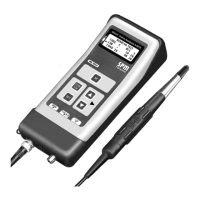50
Technical data are subject to change without notice.
ISO 9001 certified. © Copyright SPM 1996-9. 71411.B
SPM Instrument AB • Box 4 • S-645 21 Strängnäs • Sweden
Tel +46 152 22500 • Fax +46 152 15075 • info@spminstrument.se • www.spminstrument.se
Patterns from Poorly Lubricated Bearings
Fig. 33
Fig. 34
Fig. 35
CODE B and a LR/HR reading with a small delta are
typical for dry running bearings (fig. 33).
If the signal is strongest on the bearing housing, it can
have several causes:
1 insufficient lubricant supply to the bearing (poor
oil flow; old, caked, or cold grease)
2 very low or very high bearing speed (preventing
the build-up of an oil film separation between the
loaded rolling elements and the raceway)
3 installation fault (excessive preload) or out of
round bearing housing
4 misalignment or bent shaft.
If possible, grease the bearing or increase the oil flow.
Measure immediately afterwards, and again a few
hours later. In case 1 (see above), the shock pulse
level should drop and stay low.
In case 2, one can try lubricants of a different viscosity
or use additives to prevent metal to metal contact
between the bearing surfaces.
In cases 3 and 4 (installation faults, unround housings,
and misalignment), the shock pulse level may drop
after lubrication but will soon rise again. Misalign-
ment normally affects the bearings on both sides of
the coupling or at both ends of the shaft.
Cavitation and Similar Interference
The shock pulse pattern caused by a cavitating pump
(fig. 34) or by persistent rubbing is identical with that
from a dry running bearing. You have an interference
signal when the shock pulse level is highest outside of
the bearing housing and is not affected by lubricating
the bearing.
If you cannot remove the cause of interference, you
have a ”blind spot”: up to a certain level, the interfer-
ence signal (fig. 35, grey area) will mask the signal
from one or more bearings. However, you may still be
able to detect bearing damage. When the shock level
rises above the interference level, it must be caused
by something else – probably bad bearing condition.
In that case, greasing the bearing should cause the
level to drop, at least temporarily.
A
B

